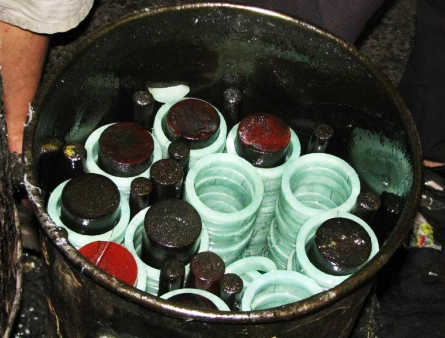Identifying jade (jadeite or nephrite) is not normally a difficult task for the experienced gemologist. Many jewelers and gemologists, however, are still very intimidated by jade when it comes to valuing it or buying off the street. Why is this?
This is actually a very educated and legitimate concern!
While identifying jadeite is not difficult with the right equipment, distinguishing “B Jade” (polymer/resin impregnated jadeite) from “A Jade” (natural, untreated jadeite) can be impossible without spectroscopy, an advanced form of gemological testing that is uncommon in jewelry stores and independent gem labs due to the expense of the machine.
So what if a customer comes into your store with jadeite, but needs to know if it is “A Jade” or “B Jade?” While it can be sent in to Mason-Kay Jade for proper testing, your customer may want to have an idea as to whether or not it is “real jade” before spending the money to have it tested.
Here are some indications of ‘B Jade’ you can look for in your store to determine if you think the piece should be sent in for advanced gemological testing:
#1. How much did it cost?
Natural jadeite is rare and valuable, so if a customer purchased what appears to be bright apple green / fine jade for a price that seems too good to be true…It probably is.
But of course, the seller may not have valued it appropriately so the price of the item is obviously not a sure indicator. It can, however, help the customer determine if they think it is worth spending on testing. For instance, a customer may say “I only paid $20 for this piece, so it’s not really worth it to me to spend $100 on testing.”
#2. How is it cut and set?
Natural jade usually (but not always!) does not come in calibrated sizes, as the cutter will typically try to make the best use of the rough. Additionally, jadeite isn’t usually cut as a flat bottom cabochon, but may be rounded and even sometimes uneven on the bottom side. It’s also uncommon for jade to be backed or set in a mounting with metal behind the stone. Most natural jade is set in mountings where you can observe the bottom of the stone and see that it’s real. Don’t make a rash assumption though just because of the cut and setting, as there are exceptions to every rule.
#3. Is it a bangle? Does it “ping?”
Natural, unfractured jade bangles, if dangled from a string and struck with a metal rod, will sing out a beautiful resounding “ping.” “B Jade” sounds clunky and abrupt, having no ping due to the internal fracturing.
This is very telling but not a conclusive test for multiple reasons:
-If it’s a natural jade bangle that is fractured on the inside, it will not ping. However, you will probably be able to see these fractures. Nonetheless, the absence of a “ping” doesn’t always mean it isn’t jade.
-If it’s a dyed green quartz bangle, it will ping and sound very similar to natural jade. Therefore, the “ping” isn’t always an indicator.
The best way to know for sure whether your jade is natural is to send it to a reputable gem lab such as GIA or AGL, or a knowledgeable supplier such as Mason-Kay Jade who offers laboratory testing.
For more information, visit:
https://masonkay.com/jadeite-services-and-fees
https://masonkay.com/storage/app/media/Mason-Kay-Guide-to-Natural-vs-Treated-Jade.pdf

